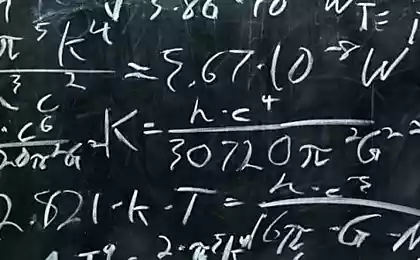675
7 biggest unsolved mysteries of science
Over the last two centuries science has answered many questions about the nature and the laws which it obeys. We were able to explore the galaxies and the atoms that make up matter. We have built machines that can think and solve problems, beyond the decision of the human forces. We decided the age-old mathematical problem and created the theory which gave to mathematics a new problem. This article is not about these achievements. This article is about the problems in science that are still forced scientists to look for and thoughtfully scratching your head in the hope that someday these questions will lead to the exclamation "Eureka!".
Турбулентность

Turbulence — the word is not new. It is known to you as the word that describes a sudden shaking during the flight. However, the turbulence in the mechanics of fluids is another matter entirely. The flight turbulence, technically called "turbulence at the clear sky," occurs when two bodies of air moving at different speeds. Physicists, however, hardly explain the phenomenon of turbulence in fluids. Mathematicians have nightmares about it.
Turbulence in fluids surrounds us everywhere. The jet flowing from the tap, completely breaks down into a chaotic fluid particles that is different from uniform flow that we receive when we open a tap. This is one of the classic examples of turbulence, which is used to explain the phenomenon of pupils and students. Turbulence is common in nature, it can be found in various geophysical and oceanic flows. It is also important to engineers as often born in flows over turbine blades, flaps and other elements. Turbulence is characterized by random fluctuations in variables such as velocity and pressure.
While on the subject of turbulence, there have been many experiments and received a lot of empirical data, we are still far from a convincing theory about what causes turbulence in the liquid, as it is controlled and what organizes the chaos. The solution to the problem is complicated by the fact that the equations governing the fluid motion — the Navier-Stokes equations — is very difficult to analyze. Scientists have resorted to high-performance computing methods, along with experiments and theoretical simplifications in the process of studying phenomena, but the complete theory of turbulence. Thus, the fluid turbulence remains one of the major unresolved problems of physics today. Nobel laureate Richard Feynman called it "the most important unsolved problem of classical physics". When quantum physics Werner Heisenberg was asked if he stood before God and had the opportunity to ask him about anything, what would it be, and the physicist replied: "I would ask him two questions. Why relativity? And why turbulence? I think the first question he will definitely be the answer."
Resource Digit.in has got a chance to talk with Professor Rodnom the Northern United States and Canada and here's what he replied:
"Today, we are not able to predict the simplest turbulent flows, without resorting to experimental data about the flow. For example, it is currently impossible to predict the pressure loss in a pipe with turbulent flow, but thanks to clever use of data obtained in experiments, it is known. The main problem is that the interesting problems of turbulent flows are almost always highly nonlinear, and mathematics, which would be able to cope with such extremely nonlinear problems, does not seem to exist. Among many physicists for a long time the belief was common that when a topic POPs up a new problem, somehow, as if by magic needed to solve the math suddenly turns out to be already invented. The turbulence problem shows an exception to this rule. The laws that govern the problem are well-known and to simple liquids under pressure in normal conditions is enclosed in the Navier-Stokes equations. But the decisions remain unknown. The present mathematics is ineffective in solving the problem of turbulence. As said by Richard Feynman, turbulence remains the greatest unsolved problems of classical physics".The importance of studies of turbulence spawned a new generation of computational techniques. The solution, though approximate, theory of turbulence will allow the science to do the best weather, to design energy-efficient cars and planes and better understand various natural phenomena.
The origin жизни

We've always been obsessed with exploring the possibility of life on other planets, but there is one issue that worries scientists more: how life appeared on Earth? Although the answer to this question will not bring much practical use, the path to the answer can lead to some interesting discoveries in fields from Microbiology to astrophysics.
Scientists believe that the key to understanding the origin of life can be figuring out how two characteristic features of life — reproduction and genetic transmission appeared in the process molecules that have the ability of replication. This led to the formation of the so-called theory of "primordial soup" in which the young Earth mysteriously appeared in the mix, a sort of soup of molecules, which are saturated with energy from the sun and lightning. For a long time, these molecules had to arise in more complex organic structures of which life consists. This theory has received partial support in the process of the famous experiment of Miller-Urey, two scientists have created amino acids, flowing electrical charges through the mixture of simple elements of methane, ammonia, water and hydrogen. However, the discovery of DNA and RNA restrain primordial enthusiasm, because it seems impossible that such an elegant structure, like DNA, can develop from a primitive soup of chemicals.
There is a current that assumes that the young world was more RNA-world, than a DNA world. RNA, as it turned out, has the ability to accelerate the reaction, while remaining unchanged, and store the genetic material along with the ability to reproduce. But to call the original RNA Replicator of life instead of DNA, scientists have to find evidence of elements that could form nucleotides — the building blocks of RNA molecules. The fact that nucleotides are extremely difficult to produce even in the laboratory. Primordial soup seems incapable of product of these molecules. This conclusion has led to another school of thought that believes that organic molecules present in primitive life have an extraterrestrial origin and was brought to Earth from space on meteorites that have led to the development of the theory of panspermia. Another possible explanation is the theory of "iron-sulfur world," which argues that life on Earth formed deep under water, out of the chemical reactions that occur in hot water under high pressure, was found near hydrothermal vents.
It is noteworthy that even after 200 years of industrialisation we still don't know how on Earth there was life. However, interest in this task always remains at a good temperature level.
Folding белка
Journey to the halls of memory will lead us to the school lessons of chemistry or physics, which we all loved (well, almost all), where we explained that proteins are extremely important molecules and the building blocks of life. Protein molecules consist of sequences of amino acids which influence their structure and, in turn, determine the specific activity of the protein. How protein fits and adopts unique native spatial structure, remains an old mystery in science. A Science magazine once called the protein folding one of the major unsolved problems of science. The problem, in essence, consists of three parts: 1) how exactly is protein evolyutsioniruet in its final native structure? 2) can we derive a computational algorithm to predict the protein structure from the sequence of its amino acids? 3) given the large number of possible conformations as the protein is placed so quickly? Over the last few decades on all three fronts there has been a considerable progress, however scientists still have not fully deciphered the mechanisms and the hidden principles of protein folding.
In the process of folding involves a large number of forces and interactions that allow the protein to attain a state of lowest possible energy, which gives it stability. Because of the great complexity of structure and a considerable quantity of the involved force fields, it is difficult to understand the exact physics of the folding process of small proteins. The problem of predicting the structure has tried to solve in combination with physics and powerful computers. Although small and relatively simple proteins there has been some success, scientists are still trying to accurately predict the folded form of a complex multi-domain proteins by their amino acid sequence.
To understand the process, imagine that you are at the intersection of a thousand roads that lead in one direction, and you need to choose the path that will lead you to your destination in the shortest time. Exactly the same, but the larger problem lies in the kinetic mechanism of protein folding in a particular state of the possible. It was found that random thermal motion plays a large role in the rapid nature of protein folding and that "flies" through the conformation locally, avoiding the adverse structure, but the physical path remains an open question — and its decision could lead to the emergence of faster algorithms that predict protein structure.
The problem of protein folding remains a hot topic in biochemical and biophysical studies of modernity. Physics and computational algorithms developed for protein folding, led to the development of new synthetic polymeric materials. In addition to the contribution to the growth of scientific computing, the problem has led to a better understanding of diseases like type II diabetes, Alzheimer's, Parkinson's and Huntington's — these disorders are improper protein folding plays an important role. Better understanding of the physics of protein folding can not only lead to breakthroughs in materials science and biology but also to revolutionize medicine.
Quantum theory гравитации
We all know about the Apple that fell on Newton's head and led to the discovery of gravity. To say that the world hasn't been the same, — to say nothing. Then came albert Einstein with his General theory of relativity. He again looked at the gravity and the curvature of space-time fabric of which the universe consists. Imagine a heavy ball, lying on the bed, and a small ball which lies nearby. Heavy ball pressure on the sheet, bending it, and the small ball rolled towards the first ball. The theory of gravitation of Einstein works smartly and even explains the bending of light. However, when it comes to subatomic particles, which is explained by the laws of quantum mechanics, General relativity gives quite strange results. The development of the theory of gravity, which will unite quantum mechanics and relativity, the two most successful theories of the 20th century, remains the major research objective of science.
This problem gave rise to a new and interesting area in physics and mathematics. The greatest attention was attracted by the so-called string theory. String theory replaces the notion of a particle is a tiny vibrating strings which can take various forms. Each string can vibrate in a certain way, which gives it a certain mass and spin. String theory is incredibly complex and mathematically arranged in ten dimensions of space-time — six more than we used to think. This theory successfully explains many oddities of marriage of gravity with quantum mechanics and at one time was a stable candidate for the position of "the theory of everything".
Another theory, formulating quantum gravity, called loop quantum gravity. PKG is rather less ambitious and tries to be, above all, confident theory of gravitation, without raising at the Grand unification. PKG represents space-time as the fabric formed by tiny loops, hence the name. Unlike string theory, loop quantum gravity does not add unnecessary dimensions.
Although both theory have their pros and cons, the theory of quantum gravity remains an unresolved issue, since none of the theories have not been proven experimentally. Experimental verification and validation of all of the above theory remains a giant problem of experimental physics.
The theory of quantum gravity is unlikely to have a significant effect in our everyday lives, however, being discovered and proven to be a powerful indication that we are far advanced in science and can move forward in the direction of the physics of black holes, time travel and wormholes.
Hypothesis Римана
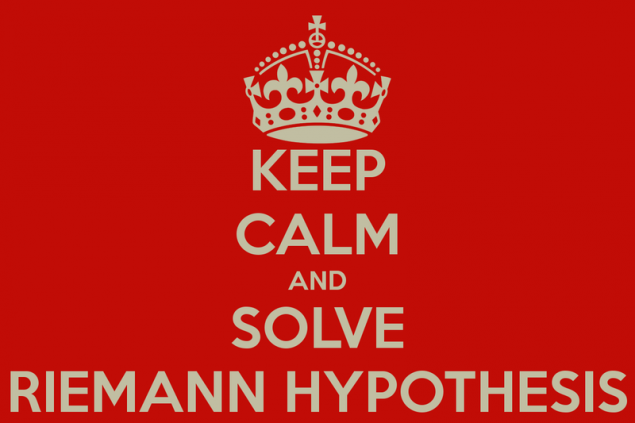
In one interview, a famous number theorist Terence Tao called the Prime numbers are the atomic elements of the theory of numbers, pretty good feature. Prime numbers have only two divisors, 1 and the number itself, and thus they are the simplest elements in the world of numbers. Primes is also extremely fragile and do not fit into templates. Large numbers (product of two primes) are used to encrypt millions of secure transactions online. Simple factorization of such numbers will take forever. However, if we somehow grasp a casual, at first glance, the nature of Prime numbers and better understand their work, we approach something great and literally break the Internet. The solution to the Riemann hypothesis may lead us ten steps closer to the understanding of Prime numbers and will have serious consequences in the banking, commercial structures, and security.
As already mentioned, primes are known for their difficult behavior. In 1859 Bernhard Riemann found that the number of primes not exceeding x, is a function of the distribution of Prime numbers, denoted by PI (x) is expressed through the distribution of so-called "nontrivial zeros" of the Zeta function. The decision related to the Riemann Zeta function and the associated distribution of points on the line of integers for which the function is equal to 0. A hypothesis associated with a particular set of these points, the "trivial zeros", which is believed to lie on the critical line: all nontrivial zeros of the Zeta function have real part equal to½. This hypothesis was confirmed more than a billion of such zeros and can open the mystery Shrouding the distribution of Prime numbers.
Any mathematician knows that the Riemann hypothesis is one of the major mysteries unanswered. The decision will not only affect science and society, but also guarantees the author of the solution a prize of one million dollars. This is one of the seven great mysteries of the Millennium. Attempts to prove the Riemann hypothesis were a great many, but they all remained unsuccessful.
Coping mechanisms тихоходок
Tardigrades — a class of microorganisms that are quite common in nature in all climates and at any altitude of our seven continents. But this is no ordinary micro-organisms: they possess extraordinary abilities to survive. Take the first living organisms that can survive the dangerous vacuum of space. Some animals went into orbit rocket "Foton-M3", was subjected to all sorts of cosmic radiation and returned almost unharmed.
These organisms are not only able to survive in space, but also can withstand temperatures just above absolute zero and the boiling point of water. They also bear the pressure of the Mariana trench, 11 km-long fissure in the Pacific ocean.
Research reduce some incredible abilities of the animals to the cryptobiosis, anhydrobiosis (drying) is a state in which metabolic activity is extremely retarded. Drying allows the creature to lose water and almost stop the metabolism. Having access to water, tihohodka recovers its original state and continues to live like nothing happened. This ability helps her survive in the desert and drought, but how this "little water bear" manages to survive in space or at extreme temperatures?
In its dried form tihohodka activates certain vital functions. The sugar molecule prevents cellular expansion, and produced the antioxidants neutralize the threat posed by reacting with oxygen molecules present in the cosmic radiation. Antioxidants help to repair damaged DNA, and this ability explains the ability tihohodka to endure extreme pressure. Although all these functions explain the supernatural powers of animals, we know very little about their functions at the molecular level. The evolutionary history of small water bears too remains a mystery. Whether their talents with an extraterrestrial origin?
The study of animals can have interesting consequences. If cryonics will become possible, using it will be incredible. Medicines and tablets can be stored at room temperature, it will be possible to create supercalender to explore other planets. Astrobiologists will tune their instruments to search for life beyond Earth more precisely. If the microorganism on Earth could survive in such unbelievable conditions, it is likely that the satellites of Jupiter are tardigrades and sleep, waiting until they find.
Dark energy and dark материя
The study of matter on Earth can be compared to picking in the sandbox. All matter known to us is only about 5% of the known Universe. The rest of the Universe is "dark" and mostly consists of "dark matter" (27%) and "dark energy" (68%).
Any list of unsolved problems in science would be incomplete without a mention of the mysterious dark matter and dark energy. Dark energy acts as proposed by reason of expansion of the Universe. In 1998, when two independent groups of scientists have confirmed that the expansion of the Universe is accelerating, it has denied popular at that time believed that the gravity slows down the expansion of the Universe. Theorists are still scratching their heads trying to explain it, and dark energy remains the most suitable explanation. But what it really is — nobody knows. There is speculation that dark energy may be a property of space, a kind of space energy, or space, penetrating fluids, which inexplicably lead to the accelerated expansion of the Universe, while "ordinary" energy is not capable of.
Dark matter is also strange. It is almost nothing interacts, even with the light, significantly complicating its detection. Dark matter was discovered, along with oddities in the dynamics of some galaxies. A known mass of a galaxy cannot explain the discrepancy with the observed data, so the researchers came to the conclusion that there is some form of invisible matter, the gravitational pull which holds the galaxy together. Dark matter has never been observed directly, but scientists have observed effects rendered to it with the help of gravitational lensing (distortion of light interacting with the invisible gravitational matter).
The composition of dark matter remains one of the greatest problems in particle physics and cosmology. Scientists believe that dark matter consists of exotic particles — vinov — which owe their existence to the theory of supersymmetry. Scientists also suggest that dark matter may consist of baryons.
While both theory — dark matter and dark energy arise from our inability to explain some observed features of the Universe, they are in essence the fundamental forces of the cosmos and attract funding for large experiments. Dark energy repels, dark matter attracts. In case of a prevalence of one of the forces accordingly and decide the fate of the Universe — will it expand or shrink. But while both theories remain dark as the originators of their occurrence. published
P. S. And remember, only by changing their consumption — together we change the world! ©
Source: hi-news.ru

